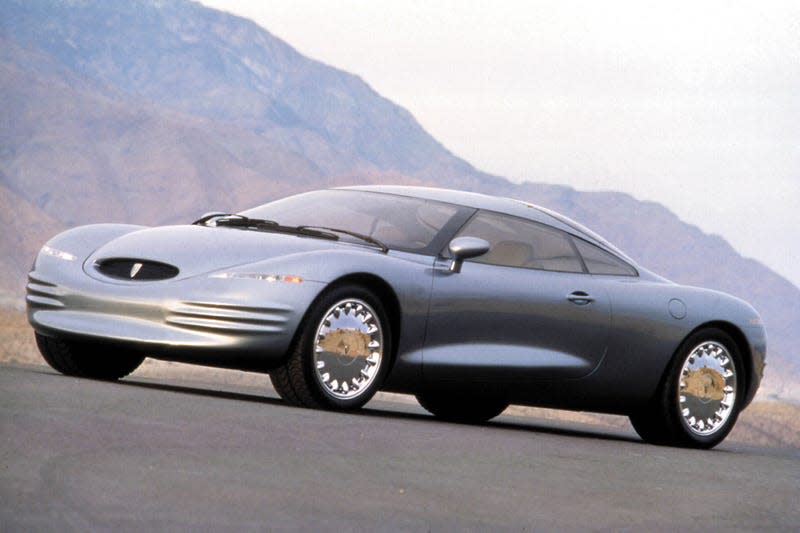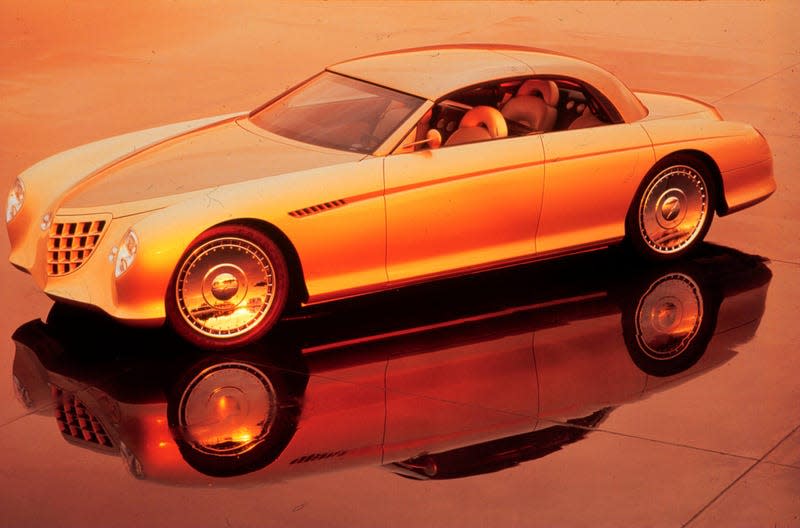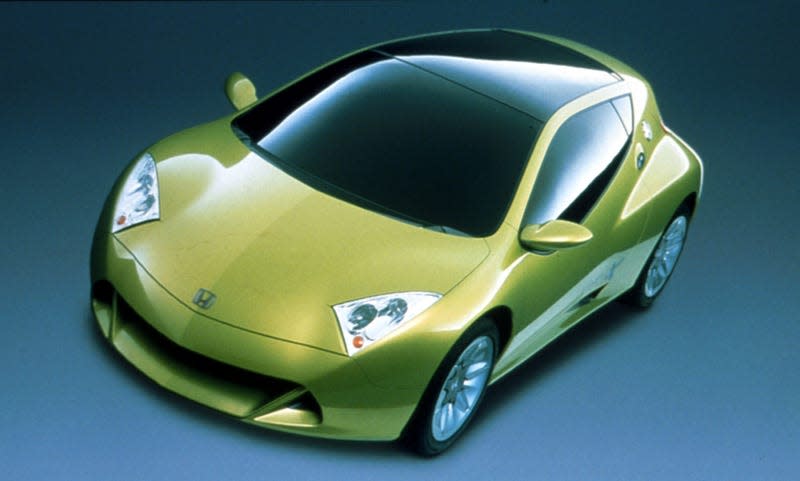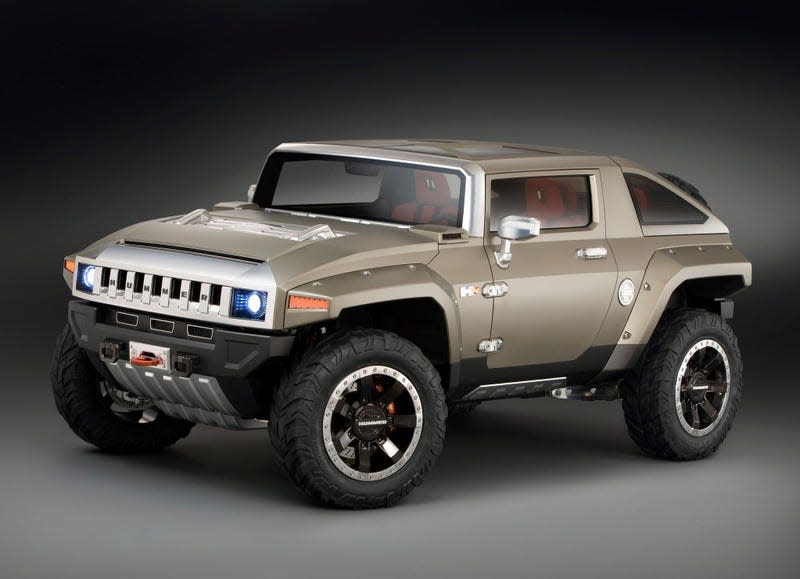Amazing Concept Cars We Totally Forgot About

My son was playing with a few of my old die-cast cars from when I was a kid — Hot Wheels and stuff like that. Among the collection were a few concept cars I had loved as a kid, but completely forgot about later. You may have too. Concept cars are typically just that: Concepts. These cars typically never see the light of day, and end up either stored away or scrapped. Even the ones that previewed future technological innovations and design details ended up promptly forgotten. Take a trip down memory lane with us as we reminisce about a few of those forgotten concepts.
Pontiac Rageous (1997)

Exemplifying Pontiac’s sporty design, the Rageous was a “four-door coupe”
with small rear doors like a Mazda RX-8 and a liftback trunk that was honestly pretty cool. With the liftback opened and rear seats folded, the concept had 49 cubic feet of storage space. Pontiac sportiness meant a little kick under the hood as well, with power coming from a 315-horsepower V8.
Read more
The sporty design language continued inside with lots of ‘90s flair. This Pontiac even had an early form of music streaming, provided through a communication link by a CD pay-to-listen service that piped in the driver’s favorite music.
Chrysler Thunderbolt (1993)

Released as a concept in 1993, the Thunderbolt was a handsome-looking coupe that inspired the cab forward design Chrysler popularized in the 1990s. Power came from a 4.0-liter 8-cylinder engine that made 270 hp. Inside it had a center stack that housed a navigation system and full entertainment center with the ability for video and computer capabilities. Talk about a preview of things to come!
Cadillac Vizon (2002)

You may recognize the Vizon concept. Yes, it was essentially a preview of what would eventually become the first-generation SRX. The concept was powered by the same Northstar V8 engine as the production SUV. One thing that didn’t make it to production, however, was the slick rear cargo area. The cargo floor could be raised, lowered, and articulated in and out of the rear tailgate for easy loading and unloading.
Audi Avus Quattro (1991)

One of Volkswagen Auto Group’s crown jewels, the W-12 engine was still early in its development in the early 1990s. But it was far enough along that it could be thrown into a concept car. Enter Audi’s Avus Quattro concept. Made as a rolling showcase to highlight Audi’s expertise in aluminum bodywork, as well as that innovative engine, the Avus was a mid-engine supercar with a 6.0-liter W-12 behind the seats promising 500 hp.
BMW Z13 (1993)

BMW went on a weird city-car kick in the early 1990s. After making a precursor to the i3 called the E1 (or Z11) in 1991, BMW went extra quirky with its next city car concept, the Z13 you see here. It may have had production intent, as engineers were tasked with designing an affordable car to slot below the 3 Series.
The interior was especially unique: The driver sat in the center, much like the McLaren F1, with passengers flanking on either side. Legroom was plentiful despite its small appearance. An aluminum body helped the Z13 weigh less than a Miata, coming in at 1,830 pounds. Power came by the way of the K1100 motorcycle engine, a 1.1-liter 88 hp inline-four.
GMC Terracross (2001)

GMC had a unique conceptual design language in the early 2000s that didn’t quite translate over into its production vehicles. Designers called it “Industrial Precision” and the Terracross was the second concept to showcase that language. Its reconfigurability was its most unique aspect.
It had a three-panel sliding roof that stopped at three different positions, including a huge open-air setting or an open cargo box for tall items. It also used GM’s ingenious midgate system with an integrated sliding rear window, and when used with the reconfigurable roof, could be used to haul tall things much like the Envoy XUV’s Midgate. Power came from a 3.4-liter V6.
Pontiac Piranha (2000)

Pontiac was all about driving excitement for the 21st Century with its early 2000s concepts. The Piranha definitely emulated that excitement. It certainly helped that power for the Piranha came from a supercharged version of GM’s 2.2-liter Ecotec four-cylinder with 212 hp.
While it looked like a coupe, this concept actually had two small suicide doors in the rear for flexibility. That flexibility continued inside with door panels that came with different color coverings that could be unzipped and swapped as your mood determined. The seats were designed to be lightweight, foldable and removable, and doubled as beach chairs. At the rear, the cargo area had a built-in removable cooler. When this cooler was removed, the cargo area turned into a small pickup bed with a fold-up tailgate.
Chrysler Phaeton (1997)

The Chrysler Phaeton Concept was a tribute to classic Chryslers from the 1920s and 1930s, mainly the Newport Phaeton and Imperial parade Phaeton. It was a huge and striking four-seat hardtop convertible. Inside was just as luxurious as you’d expect, with Zebrano wood trim, satin metal trim, and rear passenger controls for climate and sound.
Its engine was equally unique. Under that long triangular hood sat a 5.4-liter V12, created by fusing two of Chrysler’s 2.7-liter V6 engines together.
Pontiac REV (2001)

According to Pontiac, the REV was a sports car with rally-car inspiration. That explained why it had a raised ride height with adjustable suspension, all-wheel drive, and power from a 3.0-liter 245-hp V6. Pontiac touted the REV’s five speed “sequential shift” transmission, which the brand says was like being in a video game. Oh, and the rear doors were sliders, like a minivan.
Honda JV-X (1997)

Billed as the world’s first hybrid supercar, the JV-X looked like Honda hired Lamborghini’s headlight designers. The concept even had scissor doors! But what really made it unique was an early version of Honda’s IMA system with a 1.0-liter three-cylinder VTEC engine paired with a supercapacitor — stuff we’re still seeing in concept cars today.
Saturn Curve (2004)

With a design penned by the former head of Saab design, the Curve was Saturn’s attempt to attract younger buyers to the brand. The Curve was one of three concepts (the others being the Pontiac Solstice and Chevy Nomad) to ride on GM’s rear-wheel drive Kappa platform. It was all sports car, from its 20-inch wheels with performance tires to its clamshell hood and curved dashboard. Power came from a supercharged 2.2-liter Ecotec four-cylinder borrowed from the Chevy Cobalt SS and Saturn Ion Red Line.
Hummer HX (2008)

Hummer’s popularity was starting to wear off by the end of the 2000s. The H3 wasn’t bringing in customers like GM thought it would, so designers got to thinking of something smaller that could attract new buyers. The result was the Jeep Wrangler-fighting HX concept. It was a Hummer through and through, riding on huge 35-inch off-road tires and featuring a removable roof and doors. Inside there was a rubberized floor, a heavily chromed instrument panel, and room for four. Unlike its H1, H2, and H3 Alpha cousins, the HX used a smaller engine: Power came from a 3.6-liter V6 with over 300 hp.
While it was downsized, the HX was a proper Hummer underneath its skin. There was full time four-wheel drive, Fox shocks with 11 inches of suspension travel, and 13 inches of ground clearance.
Dodge Big Red Truck (1998)

The Big Red Truck Concept from Dodge was made to satisfy the mini big-rig dreams of many truck buyers and fans. The semi-truck styling was clear at a glance, with the high aero roof with clearance lights, power-bulge hood, integrated tow hooks, aluminum wheels, dual rear tires, and of course, a fifth-wheel trailer hookup.
Inside, the aero roof gave the interior 10 extra inches of headroom and ample storage space. Designers moved the center console to provide a pass-through for passenger access to the rear. There was also a rear entertainment system with a six-inch fold-down LCD flat screen TV, a tape player, rear audio controls and five rear cup holders. Power was proper for what was essentially a Ram 3500. Under the hood was the new 5.9-liter Cummins turbodiesel straight six with 235 hp and 460 lb-ft of torque.
More from Jalopnik
Sign up for Jalopnik's Newsletter. For the latest news, Facebook, Twitter and Instagram.

 Yahoo Autos
Yahoo Autos 